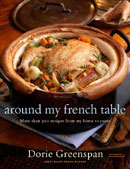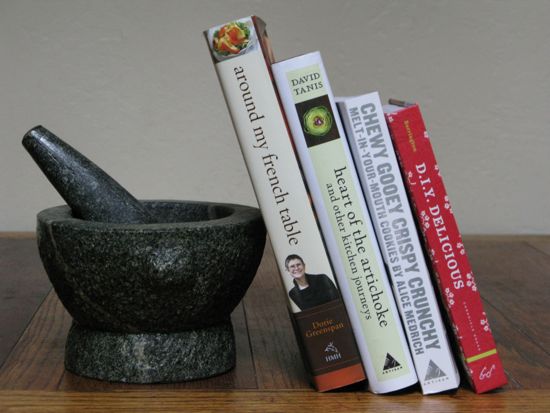A cookbook needs to be more than a compendium of recipes to catch my eye these days. My shelves already are overflowing with encyclopedic tomes and the Internet covers almost every culinary base if you make careful choices.
What I want is a cookbook with personality, one I can curl up with on a rainy afternoon as well as take into the kitchen for a marathon session with the pots and pans. It should offer a new way of looking at food and act as my trusted guide in the kitchen.
That’s a tall order and few new cookbooks measure up. So I’m not going to offer my own variation on The Ten Best Cookbooks of 2010 here. Instead, I’m showcasing the handful of offerings that qualify as keepers in my kitchen. With the exception of Dorie Greenspan’s irresistible best seller, I’ve focused on the works of Bay Area authors.
Any of these books would make a welcome gift for the enthusiastic cook this season. If you’re really feeling generous, you could match it with a new piece of kitchen equipment that fits the author’s cooking style.
 “Around My French Table,” by Dorie Greenspan (Houghton Mifflin Harcourt, 2010, $40)
“Around My French Table,” by Dorie Greenspan (Houghton Mifflin Harcourt, 2010, $40)
Greenspan is one of those authors you want to call by her first name because it feels like she’s writing just for you. Her prose is so enthusiastic, it’s contagious.
She made her name with sugar, butter and flour, writing baking books with the likes of Julia Child and Pierre Herme. Now, she’s venturing into savory cookbooks for the first time.
“Around My French Table” is filled with anecdotes and recipes from her experiences living part of each year in Paris. This is the food I could happily eat for the rest of my life. Her recipes are relatively simple and she figuratively holds your hand through each step of preparation.
Every recipe I tried–puffy gougeres, classic onion soup, and an aromatic chicken and vegetable couscous – were all winners. I can’t wait to taste her boeuf a’la mode, a slow-cooked pot roast made with chuck or rump roast, vegetables and a bottle of fruity red wine.
Although the gorgeous photographs by Alan Richardson are worthy of a coffee table book, this is a cookbook you’ll want to keep in the kitchen. It will appeal to the experienced cook as well as the budding Francophile.
For a really special present, pair it with a enameled Dutch oven, the essential pot for a number of Greenspan’s recipes. Le Creuset, a French import, is the gold standard, but the covered pots run more than $200. Lodge makes a highly-rated model for under $100.
 “Heart of the Artichoke and Other Kitchen Journeys,” by David Tanis (Artisan, 2010, $35)
“Heart of the Artichoke and Other Kitchen Journeys,” by David Tanis (Artisan, 2010, $35)
David Tanis, who shares the post of head chef at Chez Panisse, is another one of those lucky people who get to live half the year in Paris. He calls himself “a restaurant chef who has always preferred to cook at home” and his seasonal recipes are designed for flavor and conviviality rather than show.
Tanis celebrates the craft of cooking. He takes pleasure in peeling fruit, kneading bread, boiling up small batches of jam, and slowly braising a pork roast in a sauce made from dried New Mexico chiles. Other times he’s just as content to pass around a platter of fresh strawberries and bowls of creme fraiche and sugar for dessert.
When I first thumbed through his previous book, “A Platter of Figs,” I wasn’t impressed. There were few culinary surprises and the food often seemed too simple to merit a recipe. Yet I found myself returning to it again and again because it delivered the sort of food I really wanted to eat.
This new volume is written in the same spirit, but Tanis more clearly states his kitchen philosophy and offers an extra measure of anecdotes to go with his appealing recipes. He prefaces his dinner menus for each season with little essays on his personal kitchen rituals, from building a flawless ham sandwich with a fresh baguette and good butter to making his own chorizo sausage.
Attention to detail is what sets Tanis’ recipes apart. His fresh-tasting salad of romaine lettuce hearts, shaved Parmigiano cheese and a bright lemon dressing rivals the best Caesar salad. The buckwheat galettes, Brittany’s hearty version of crepes, were easier than expected and so good, I’m including the recipe below. Come summer, I’m sure his layered tomato and bread salad will be a staple at my house.
This is a book for the cook who finds joy working with fresh, local ingredients in season. The most appropriate piece of equipment to give with it would be a mortar and pestle. Tanis keeps about a dozen in his kitchens for pounding the garlic, spice and herbs essential to his recipes.
 “Chewy Gooey Crispy Crunchy Melt-in-Your-Mouth Cookies by Alice Medrich,” by Alice Medrich (Artisan, 2010, $25.95)
“Chewy Gooey Crispy Crunchy Melt-in-Your-Mouth Cookies by Alice Medrich,” by Alice Medrich (Artisan, 2010, $25.95)
It’s hard to believe the world needs another cookie book. But when Alice Medrich is the author, what cookie lover can resist checking it out. I wasn’t disappointed.
The diva of chocolate has produced a truly original collection of recipes, many of them inspired variations on old standards. In her hands, even the ubiquitous chocolate chip cookie gets a delicious new personality with whole wheat pastry flour and an extra measure of chopped nuts. She also introduces gluten-free versions of most of her cookies and brownies, although I confess I didn’t test them, and creates cookies to fit the Weight Watchers point system.
The recipes are organized by texture, making it easier to find the cookie that best fits your taste. One of the most intriguing new category of cookies is the thin, crisp sticks designed for maximum crunch. The coconut sticks reminded me of tender, intensely flavored biscotti.
This is a book for cooks who like to indulge their inner cookie monsters. It would pair nicely with a kitchen scale, which Medrich recommends using for best results, or a cookie scoop with a squeeze-release handle.
 “D.I.Y. Delicious,” by Vanessa Barrington (Chronicle Books, 2010, $24.95)
“D.I.Y. Delicious,” by Vanessa Barrington (Chronicle Books, 2010, $24.95)
Check out the labels on the packaged foods you bring home from the supermarket and you’ll discover a whole new vocabulary of unpronounceable chemicals as well as far more fat, salt and high fructose corn syrup than anyone could imagine. Vanessa Barrington, a writer and chef based in Oakland, decided she would rather make her own condiments, crackers, pickles and cheese – as much for the satisfaction of reviving lost kitchen arts as for the health and environmental benefits.
Barrington shares what she’s learned in this charming little book with its folksy design and minimally-styled photographs. There are recipes for making mustard and ketchup as well as yogurt, fresh cheese and butter. In addition there are step-by-step guides to making fresh pasta, tortillasm kimchi and root beer. I’m a big fan of her sesame crackers.
Along the way, Barrington also offers recipes for dishes that employ the homemade pantry ingredients. I’m waiting for spring to make the fresh pasta with asparagus, homemade cheese and lemon.
This book is just the ticket for young urban homesteaders or amateur chefs who literally want to cook from scratch. To help them store all their new staples, why not wrap up a few glass canning jars, too?
Serves 6
1/4 cup roasted buckwheat groats (kasha)
1 cup buckwheat flour
1/2 cup all-purpose flour
2 eggs
2 1/2 cups whole milk
1/2 teaspoon salt
2 tablespoons butter, melted
6 thin slices good-quality cooked ham
2 cups grated Comte or Gruyere
Whirl the groats in a coffee mill until finely ground. Whisk together groats, buckwheat flour, all-purpose flour, eggs, milk, and salt in a mixing bowl until well combined and refrigerate for at least 2 hours; overnight is best.
Preheat oven to 400 degrees. Heat a crepe pan, well-seasoned cast iron or heavy nonstick saute pan (see Note) – about 8 inches in diameter – over medium high heat. Rub a little of the melted butter in the pan with a piece of paper towel, then quickly ladle in about 1/8 cup of the batter, swirling the pan to spread the batter evenly over the bottom. Let the galette brown on one side, then loosen the edge with a thin spatula and flip it over in the pan. Let cook briefly on the second side, just until set, then remove from pan and set aside while you make the rest of the galettes. (They can stack on a plate without sticking together.)
To fill, lay each galette, top side down, on a work surface. Place a slice of ham on top, sprinkle with a generous pinch of grated cheese and fold over to make a half-moon. Place the filled galettes in a single layer on baking sheet, drizzle with a little of the remaining melted butter and pop into the oven. Bake just until the cheese is melted and the galettes are crisp on the edges. Serve immediately.
Note: Tanis does not suggest a non-stick pan in his recipe but I found it easier to work with.
Adapted from “Heart of the Artichoke,” by David Tanis


Great post Aleta, though it’s mostly tempted me to buy these books for myself!
Oh, and speaking of Bay Area authors, did you get a chance to review “Tartine Bread”? One of these days, I might actually get over my fear and try to bake some. …
Sylvia, I did check out “Tartine Bread” and admired the recipes for things to do with bread, but decided I didn’t really need another bread baking book. Although I like the idea of baking my own bread, I only occasionally make the time to do it. We have access to such good bread from artisan bakers here, it hardly seems worth the effort. Maybe I’d feel differently if I lived someplace else.
Since you are The Skillet Chronicles, I thought for sure you’d suggest “From Seed To Skillet” by Jimmy Williams and Susan Heeger. 😉
I’m not familiar with that one but I’ll check it out.
Nice post, as I always like to hear others’ cookbook recommendations. I have avoided McKee until now. Being a food blogger myself, I expected to find his advice amateurish. The reviews on Amazon were as checkboard as usual, so decided to browse through “Keys to Good Cooking” at the bookstore. To my surprise I realize there was a LOT more to learn. Thank you! Otherwise I would have never checked it out, and only did so because I respect your work.